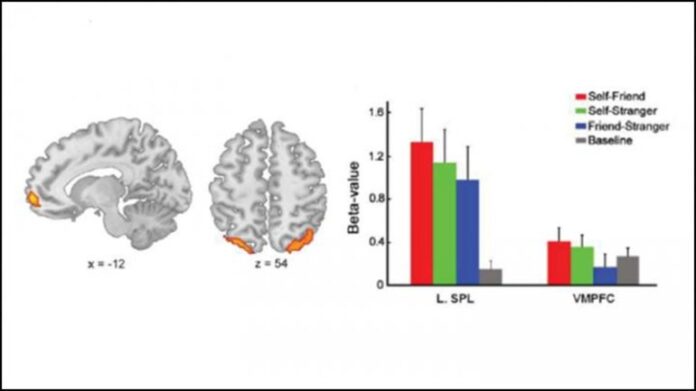[ad_1]
Summary: Study implicates the ventromedial prefrontal cortex, an area of the brain associated with information processing about the self, in self-bias memory.
Source: SfN
A brain region involved in processing information about ourselves biases our ability to remember, according to new research published in Journal of Neuroscience.
People are good at noticing information about themselves, like when your eye jumps to your name in a long list or you manage to hear someone address you in a noisy crowd. This self-bias extends to working memory, the ability to actively think about and manipulate bits of information: people are also better at remembering things about themselves.
To pinpoint the source of this bias, Yin et al. measured participants’ brain activity in an fMRI scanner while they tried to remember the location of different colored dots representing themselves, a friend, or a stranger.

The participants’ fastest response time came when recalling the dot representing themselves, even though it was an arbitrary connection. When people held the self-representing dot in working memory, they had greater activity in the ventromedial prefrontal cortex (VMPFC) — an area involved in processing self-relevant information.
Greater synchrony between the VMPFC and working memory regions corresponded to faster response times. When the researchers interfered with VMPFC activity with transcranial direct current stimulation, the self-bias disappeared, indicating activity in the region drives the bias.
About this memory research news
Source: SfN
Contact: Calli McMurray – SfN
Image: The image is credited to Yin et al., JNeurosci 2021
Original Research: Closed access.
“Ventromedial Prefrontal Cortex Drives the Prioritization of Self-Associated Stimuli in Working Memory” by Shouhang Yin, Taiyong Bi, Antao Chen and Tobias Egner. Journal of Neuroscience
Abstract
Ventromedial Prefrontal Cortex Drives the Prioritization of Self-Associated Stimuli in Working Memory
Humans show a pervasive bias for processing self- over other-related information, including in working memory (WM), where people prioritize the maintenance of self- (over other-) associated cues. To elucidate the neural mechanisms underlying this self-bias, we paired a self- vs. other-associated spatial WM task with functional magnetic resonance imaging (fMRI) and transcranial direct current stimulation (tDCS) of human participants of both sexes. Maintaining self- (over other-) associated cues resulted in enhanced activity in classic WM regions (frontoparietal cortex), and in superior multivoxel pattern decoding of the cue locations from visual cortex. Moreover, ventromedial prefrontal cortex (VMPFC) displayed enhanced functional connectivity with WM regions during maintenance of self-associated cues, which predicted individuals’ behavioral self-prioritization effects. In a follow-up tDCS experiment, we targeted VMPFC with either excitatory (anodal), inhibitory (cathodal), or sham tDCS. Cathodal tDCS eliminated the self-prioritization effect. These findings provide strong converging evidence for a causal role of VMPFC in driving self-prioritization effects in WM and provide a unique window into the interaction between social, self-referential processing and high-level cognitive control processes.
Significance statement
People have a strong tendency to attend to self-related stimuli, such as their names. This self-bias extends to the automatic prioritization of arbitrarily self-associated stimuli held in working memory. Since working memory is central to high-level cognition, this bias could influence how we make decisions. It is therefore important to understand the underlying brain mechanisms. Here, we used neuroimaging and noninvasive neurostimulation techniques to show that the source of self-bias in working memory is the ventromedial prefrontal cortex, which modulates activity in frontoparietal brain regions to produce prioritized representations of self-associated stimuli in sensory cortex. This work thus reveals a brain circuit underlying the socially motivated (self-referential) biasing of high-level cognitive processing.
[ad_2]
Source link













